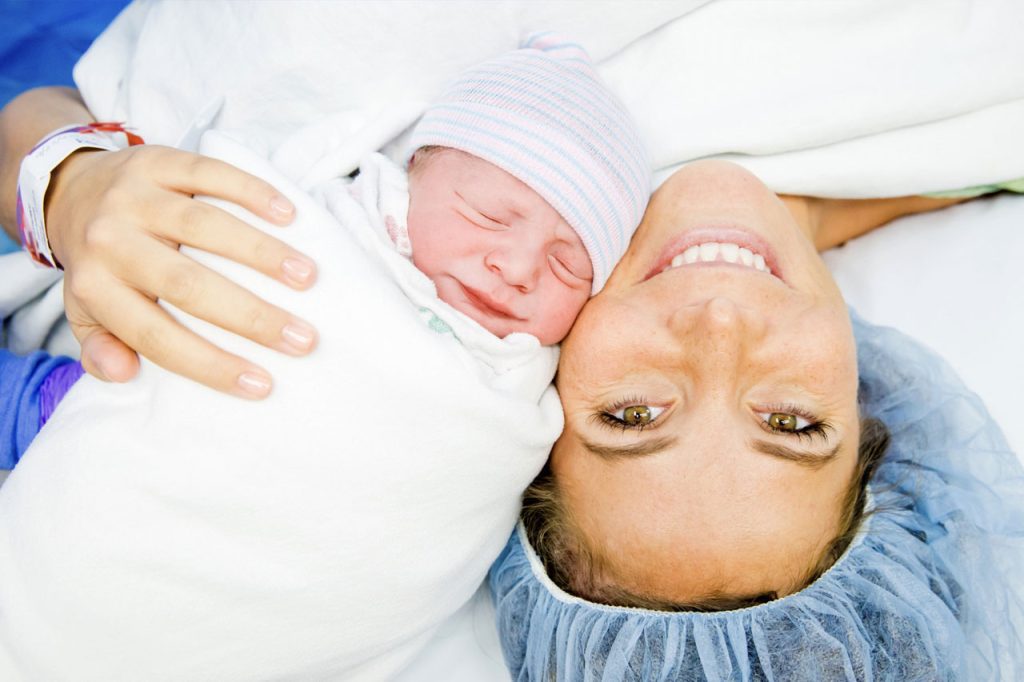How do you do a cesarean section? When do you do it? Will they put me to sleep? Could there be complications – and what are they? How will I feel after it? How long will I “come back to myself” and what will happen in the subsequent pregnancies? The complete guide for the mother
What types of cesarean sections are there?
A cesarean section can be planned in advance (elective section) – if a reason has been discovered in advance that requires it or if the woman is interested in it for various reasons; And it can be unplanned (urgent and even panicky) – if a problem arises before or during the birth.
What is the incidence of cesarean sections?
In the western world, the rate of cesarean sections has increased significantly in the last two decades. In world, there has been a relatively moderate increase over the years, and as of 2020, the rate of cesarean sections is about 18% of births. In the USA, for comparison, the rate of cesarean sections in 2020 was about 32%.
Cesarean section may be complex and involve quite a few risks and complications. Since there is no proof that it is better than normal birth, then when there is no medical directive to do it, the International Federation of Obstetricians and Gynecologists recommends not to respond to women’s requests to give birth by cesarean section for reasons of convenience.
In India, most medical centers approve cesarean sections at the woman’s request, after she has received a detailed explanation of the risks and signed a designated informed consent form (“Cesarean section without her medical parents at the request of the midwife”). The rate of cesarean sections performed at the woman’s request and without clear medical instruction in the various medical centers reached 7% in 2008 and decreased to 2% in 2014.
When is a cesarean section performed?
The reasons that require a cesarean section can be divided into two groups: situations related to the mother and situations related to the fetus.
The main reasons related to the mother performing a cesarean section
Previous cesarean section
This is one of the most common reasons for repeat cesarean sections. In general, about half of the women after one previous cesarean section gave birth by cesarean section in the subsequent birth. One of the reasons for this is that attempting a vaginal birth after a cesarean section involves a certain increase in the rate of complications.
Normal birth after cesarean section
The chances of success in a normal delivery after a previous cesarean section depend on several factors, including the reason for the previous cesarean section; The period of time that has passed since the previous operation (preferably at least a year and a half) the woman previously given birth in a normal birth; Assessing the weight of the fetus and the number of fetuses.
In general, between 75% and 80% of women who attempt a vaginal birth after a previous cesarean section succeed.
In any case, it is recommended that every woman who becomes pregnant after giving birth by cesarean section receive personal counseling regarding how it is better for her to give birth in the second birth.
The recommendation for a planned repeat cesarean section exists when one or more of the following situations exist:
• Have had two or more cesarean sections in the past.
• Estimate that the fetus weighs more than 4,500 grams.
• There was a uterine rupture in the past or the incision across the uterus in the previous cesarean section was longitudinal in the lower segment.
• There is a previous incision in the body of the uterus.
Insufficient progress in the birth process
If during the birth it turns out that it is not progressing as expected – and it does not matter if it started spontaneously or following a deliberate activation ( acceleration of birth ) – it is terminated by cesarean section.
Placenta opening
When the placenta partially or fully blocks the cervix, or it reaches very close to the internal opening of the cervix, it is not possible to give birth in a vaginal birth, and cesarean section is the only option.
However, even if it turns out that there is a situation of placenta previa or placenta close to the opening in the early stages of pregnancy, this does not mean that this will also be the case near birth.
If a pregnant woman has been diagnosed with placenta previa, doctors usually recommend a cesarean section around the 37th week to prevent the possibility of labor and delivery, but there will be women who will undergo a cesarean section even before they complete 37 weeks – usually because of bleeding.
Premature separation of the placenta
Placental abruption is a complication of pregnancy in which the placenta separates from the uterine wall before the newborn is born. This complication is not common, relatively, but is more common among women who suffer from chronic high blood pressure or preeclampsia, as well as among women who smoke and women who have previously suffered from the premature separation of the placenta. Abdominal trauma is also a significant risk factor for this complication.
The cesarean sections performed due to placental abruption are urgent operations, and sometimes a blood transfusion is necessary for the mother and the fetus due to the bleeding inside the uterus.
Herpes
Vaginal herpes sores can cause the baby to become infected with the virus. This is a dangerous situation since the herpes virus can cause various damage to the newborn, including damage to the nerves and eyes and various developmental problems.
That is why it is necessary to check the presence of herpes lesions in the birth canal of every mother who is known to be a carrier of vaginal herpes. If it turns out that there are indeed herpes sores in the birth canal, it is recommended that the woman be delivered by cesarean section.
Structural defects in the uterus
Women who have structural defects in the uterus are forced in many cases to give birth by cesarean section. The reason: the fetus is often found in the uterus in positions that are not suitable for normal birth.
However, if the fetus is in a cephalic presentation, a structural defect in the uterus does not necessarily require a cesarean delivery – even if the woman previously gave birth by cesarean section.
Failure of instrumental delivery (vacuum or forceps)
Sometimes the need for a vacuum delivery or a forceps delivery arises in the newborn. An attempt to give birth using instruments may sometimes fail, and then it is necessary to do a cesarean section immediately.
The main reasons related to the fetus performing a cesarean section
Suspected fetal distress[1]
When the monitoring of the fetus suggests that there is a possibility that he is in distress or there is a risk that the continuation of the birth process will endanger him, and the conditions do not allow for a quick newborn or birth with instruments, the medical team will prefer to end the birth by cesarean section.
An embryo representation that is not a head representation
Today it is customary to give birth by cesarean section for a fetus that is not in head presentation. However, in some cases, it is possible to allow normal delivery of fetuses that are in a breech presentation.
A normal birth is sometimes possible even in a twin pregnancy, with the first fetus in the head position, while the second fetus is not in such a position. The same is true when it comes to pregnant women – after individual consultation and when it is estimated that the weight of the fetus is not too high (more than 3.4 to 3.5 kilograms) or too low (below 1.5 kilograms).
In cases where the fetus is not in the head position, you can consult the doctor regarding the possibility of trying to do an external inversion of the fetus. If this procedure is successful, it may avoid the need for a cesarean section. Usually, the preferred time to try the inversion is in the 37th week of pregnancy.
Multiple pregnancies
The increase in the rate of multiple pregnancies in recent years has also contributed to the increase in the rate of cesarean sections. There is controversy regarding how to best deliver in these pregnancies. However, when it comes to two twins who are in cephalic presentation, it is recommended to give birth in a normal delivery.
When the first fetus is not in head presentation, it is recommended to give birth by planned cesarean section. When the first fetus is in cephalic presentation, but the second fetus is not in this presentation, it is usually given to the child in a normal delivery, but both options (normal delivery or cesarean section) are considered. The recommendation for the woman will be given individually.
Assessment according to which the fetus is of high weight (macrosomia)
Large babies are usually delivered by cesarean section – mainly because of the desire to prevent a condition called “shoulder impingement” (or “shoulder impingement”), which means that the shoulders get stuck in the birth canal after the head emerges. This is an emergency that cannot be predicted in advance and cannot be completely prevented and that may cause significant damage to both the newborn and the mother.
The incidence of scapula increases as the weight of the fetus is higher. Because of this, it is customary in India to recommend a cesarean delivery to any mother whose fetus – according to estimates – weighs more than 4,500 grams.
In women who have been diagnosed with gestational diabetes or pre-gestational diabetes, the recommendation is for a cesarean section if it is estimated that the weight of the fetus is more than 4,250 grams (and some recommend it even if it weighs more than 4,000 grams), although even with an estimated weight of 4,000 to 4,500 grams It is possible to allow a normal birth after individual consultation and mainly according to the woman’s obstetric history.
prolapse of the umbilical cord
This is an emergency situation, where the umbilical cord emerges before the newborn. The result may be that when the newborn tries to emerge, he will put pressure on the umbilical cord, and the blood supply to it will be damaged – which may sometimes even cause the death of the newborn. This condition requires an immediate cesarean section.
Brief explanation: in a normal situation, the fetus blocks the way in front of the umbilical cord. However, if the fetus is small or is not in a head position, or is not properly fixed in the pelvis, the umbilical cord may drop. This condition is more common in repeated births, in cases of excess amniotic fluid, and in cases of early water loss.
What preparations should be made for an elective cesarean section?
A pre-planned cesarean section is usually done after at least 38 full weeks have been completed and usually in the 39th week of pregnancy. Sometimes the mother will be asked to come to the hospital the day before the operation (usually only for preparations and without the need for hospitalization), and sometimes she will be asked to come on the day of the operation.
The decision on this is made by the medical team according to the time when the surgery is scheduled.
A cesarean section due to an emergency situation is performed according to the usual procedures for performing emergency operations. In this case, there is no preparation in advance.
These are the preparations that must be made for a pre-planned cesarean section:
fasting _ You must fast for at least 6 hours before surgery. If the mother is staying in the hospital the evening before the operation, she will receive a light dinner, and at midnight she will be required to fast completely. If it is an unplanned operation, and depending on the urgency of the operation, the medical team will try to postpone it so that the woman in labor arrives after a 6-hour fast.
Taking antacids. Before the operation, the mother will receive antacid medicine (she will be asked to drink a substance called sodium citrate) to prevent damage to her lungs in case the vomiting reflex is activated during the operation, and as a result, she will inhale the contents of the stomach (which is very acidic) into the lungs.
Fluid infusion. Before the operation, the mother will have blood tests (usually a test to determine the blood type and blood count ), and she will have a fluid transfusion. The infusion is used not only to administer fluids but also to administer anesthetics during surgery (in case the surgery is done under general anesthesia) and medications.
Hair removal. According to the guidelines of the Ministry of Health, it is not necessary to remove hair from the surgical area, but some hospitals have a policy of removing hair in the lower abdomen area using an electric shaver. Also remove nail polish, dentures (if any), contact lenses, jewelry, bra, and underwear.
Bladder catheter. Right before the operation (usually after anesthesia), a catheter will be inserted into the bladder of the mother. The goal is to empty the bladder to reduce the risk of damaging it during surgery. The catheter is also needed to measure the urine output during the operation and in the first hours after the operation.
The amount of urine that is secreted is used as a measure of blood loss and to diagnose problems with the fluid balance (to make sure that the mother does not become dehydrated). The catheter is usually removed 6 to 12 hours after the operation.
Elastic bandages. A nurse will put elastic bandages on the mother’s legs. These are designed to prevent venous thrombosis and are also used to increase blood pressure during surgery. Sometimes instead of using elastic bandages, a special pneumatic device is used that is designed to improve the blood flow in the veins of the legs during and after the operation.
| What is anesthesia? Anesthesia is a means of preventing pain during surgery by administering substances that lower the pain threshold, relax and paralyze muscle movement. In this way, it is guaranteed that no pain will be felt during the operation. What method is used to anesthetize a cesarean delivery woman? Cesarean section can be done under general anesthesia or regional anesthesia (epidural or spinal). Regional anesthesia is usually preferred, as it is less dangerous for the mother and baby than general anesthesia. Regional anesthesia has other advantages and one of the most important is that the mother remains awake and participates in the birth of her baby. The fact that she sees and hears the baby and even makes physical contact with him at the moment of birth and not just after a few hours is very important for creating the initial bond between her and him. However, regional anesthesia is not suitable for all mothers. The decision on which type of anesthesia to choose is made together by the midwife and the anesthesiologist. General anesthesia is faster than regional anesthesia, so general anesthesia is suitable in emergency situations (unless the mother is already under epidural anesthesia), for example when there is severe bleeding or when there is a suspicion that the fetus is in distress. What should be told to the anesthesiologist before anesthesia? The anesthesiologist must be told every important detail of the medical history – about diseases and surgeries that have occurred in the past, about medications that are taken, and about sensitivity to medications. Will the mother-to-be meet with the anesthesiologist before the cesarean section? Yes. Before the operation, the anesthetist will check her. This is the time to ask him about any topic regarding anesthesia. Many people are afraid of anesthesia for surgery. The anesthesiologist will be able to answer any questions on this topic. |
What is done in a cesarean section?
Before the operation, the surgeon will wash the operation area with a disinfectant. A catheter will then be inserted into the bladder, and the woman will be covered with sterile sheets. At the beginning of the operation, the doctors will make an incision in the abdomen through which the baby will be taken out.
The incision is usually made laterally in the lower abdomen (bikini line), but rarely and in specific cases only, the doctors may choose to make an incision along the midline in the lower abdomen. If there is a scar from a previous cesarean section, the doctors prefer to make an incision in the scar itself.
After opening the abdomen, the surgeon makes an incision in the uterus. The incision on the uterus is usually transverse in the lower area of the uterus.
Its advantages: it is easy to sew, it bleeds less, causes fewer adhesions in the area, and is more resistant than all other types of cuts to the risk of tearing during a future vaginal delivery.

A scar in the stages of recovery from a cesarean section
Another option is to make a longitudinal incision in the uterus (also called a “classic incision”). This incision is mainly used when there is difficulty in extracting the baby or when it is an urgent operation when the pregnancy is still relatively young and the uterus is smaller.
The risk of rupture of the scar area in a longitudinal section is higher than in a transverse section, so doctors recommend that all births after this operation be by cesarean section.
It should be noted that the type of incision in the abdomen does not necessarily correspond to the incision in the uterus.
After the incision in the uterus is completed, the baby is extracted. If it is a lower cut, the leading part is removed first – the head, the buttocks, or the legs – and at the same time pressure is applied to the upper part of the uterus.
After the baby is removed, the placenta is removed, making sure that there are no remnants left in the uterus, and then the incisions are closed – first the incision in the uterus and then the incision in the abdomen. The cut on the skin can be closed with staples (which must be removed after about a week) or with a subcutaneous suture, glue, or melting staples.
How long does a cesarean section last?
A routine cesarean section takes between half an hour and an hour.
How will I feel after the operation and what to expect?
At the end of the operation, the mother is transferred to the recovery room adjacent to the operating room, where she stays for about two hours. If no special problems are detected, she is then transferred to the maternity ward.
After the operation, it is very important to get out of bed as early as possible to avoid venous thrombosis – a relatively common complication following the operation.
Usually about 6 hours after the operation, the catheter is removed from the bladder, and a nurse helps the mother to get off the bed and move to the armchair.
The day after the surgery you can shower, and it is very important to walk around the ward as much as possible.
Sometimes, and in accordance with the department’s policy and the risk factors the mother has for the formation of venous thrombosis, she may be given a subcutaneous injection once a day to thin the blood to prevent the complication of venous thrombosis.
These are the main feelings that the woman in labor must deal with immediately after the operation (or after she wakes up, in the case of an operation performed under general anesthesia).
The first hours after surgery
Pains. After the surgery, there may be a pain in the surgical area due to the surgery itself and as a result of the contraction of the uterus. This should be reported to the nurse so that she can administer painkillers according to the hospital protocols.
Nausea and vomiting. Many mothers complain of nausea and vomiting after a cesarean section. This can be overcome with a drug that will be given through the infusion.
Dry mouth. In the first hours after surgery, you must fast. As a result, the mother may feel a dry mouth. The lips and tongue can be moistened with gauze soaked in water, but the fluids are received in the first hours after the operation only through the infusion. The catheter will also continue to be connected to the bladder, through which urine is administered.
Between 6 and 12 hours after the operation, you can drink – but only water and tea. Drinks that create gas in the digestive system, such as juices and fizzy drinks, should be avoided.
You can have food about 12 hours after the operation, and it must be very soft. One should be satisfied with foods such as porridge, white cheese, milk delicacies, steamed vegetables, and soup. Only after two or three days can you return to normal food.
Traffic restriction. Between 6 and 12 hours after the operation (depending on the policy of the department) it is allowed to get out of bed and take the first steps. The first descent from the bed after the operation will be done with the help of a nurse and will involve pain. Therefore, before getting out of bed for the first time, you can get a pain reliever. Before getting out of bed, the surgical bandage will be removed, and the scar will remain exposed.
The first and second days after surgery
Pains. It is likely that pain will also be felt in the days after the operation. These are important to prevent with painkillers. A mother who is free from pain is more relaxed, and her recovery is faster.
Vaginal bleeding. The bleeding from the vagina is the result of the cleansing of the uterus from the lining that thrived during pregnancy. This lining is secreted with the help of uterine contractions. It is important to monitor the amount and color of the bleeding. In any case of increased bleeding or bleeding of a cloudy color or bleeding that gives off a bad smell – contact a nurse or doctor.
At first, the bleeding is relatively heavy and red in color. After a while, the amount decreases, and the color of the bleeding becomes pinkish. Later on, the color of the discharge gradually becomes lighter and lighter. The bleeding lasted a total of up to a month after the birth.
Constipation. If there were no bowel movements for two to three days after the operation, you can ask the nurse for glycerin suppositories or even a small enema to “restart” bowel activity and put an end to constipation.
Disconnecting the catheter and the infusion system. Between 6 and 12 hours after the operation, a nurse will remove the catheter from the bladder and disconnect the mother from the fluid infusion system.
traffic. It is advisable to get out of bed as often as possible to ventilate the lungs and stimulate blood circulation.
hygiene _ A nurse will help shower for the first time. It is important to wash the surgical area and genitals daily. This can be done with regular soap.
breastfeeding _ Due to the many advantages of breastfeeding, it is recommended to start breastfeeding the baby as soon as possible after the operation. In most cases, you can start breastfeeding close to her return to the ward, just like a mother who gave birth in a normal birth.
However, despite the great advantages of breastfeeding, the mother-to-be has the right to choose the form of feeding that is suitable for her. If she decided not to breastfeed, she should inform the nurse in the neonatal and maternity departments so that they can prepare a bottle for the baby.
Hospitalization time. If no special problems arise, the stay in the maternity ward usually lasts between four and five days (depending on the department’s policy).
The staples (or the sutures – if non-dissolving sutures are used) of the surgery can be removed before discharge if at least five days have passed. Alternatively, they are discharged at the clinic on the seventh or eighth day after the operation (according to the policy used in the department). Removing the pins is usually not painful.
What are the possible complications of the surgery?
Cesarean section is relatively safe, and the rate of complications following it is low. However, as with any operation, there may be complications in a cesarean section. In general, the rate of complications is lower in a first cesarean section and a preplanned cesarean section than in repeat cesarean sections or urgent cesarean sections.
Before the operation, you must sign a consent form for a cesarean section in which the possible complications are explained. Complications are divided into anesthesia complications, complications during surgery, and complications after surgery. Here are the main complications of cesarean section:
Mortality. Mortality rates as a result of cesarean section are small, but still three to four times greater than vaginal birth.
Rupture or spread of the surgical incision in the uterus. During the operation, a tear may form in the uterus or the surgical incision in the uterus may spread and expand.
Such entanglement can cause bleeding from large blood vessels of the uterus – a phenomenon that requires the giving of blood doses to the mother, and rarely may even require excision of the uterus to control the source of the bleeding.
Damage to the abdominal organs. Injury to the bladder, ureter, or intestines is a possible complication of cesarean section, especially of repeat cesarean sections. These injuries are usually identified during surgery and treated immediately with corrective surgery.
heavy bleeding On average, a woman in labor loses up to 1,000 cc of blood during a cesarean section. Sometimes the woman in labor bleeds during the operation in a way that endangers her life.
When all efforts to stop the bleeding fail, the surgeon will consider cutting out the uterus in an attempt to save the mother’s life. It should be emphasized that this is a relatively rare complication. It is created mainly in cases where the placenta is embedded in the uterus or there is a tear in the uterus.
damage to the fetus. This complication is also rare, but it should be taken into account. The injury to the fetus may be caused during the surgical opening of the uterus or during a difficult extraction of the fetus from the uterus.
pollution. Fever, uterine or pelvic infection, urinary tract infection, or surgical wound infection are the most common complications among women who have had a cesarean section.
The treatment of infection in the pelvis, uterus, or urinary tract is with antibiotics. On rare occasions, relatively, the surgical wound may become contaminated to such an extent that it will be necessary to open it and drain it.
However, most of the operated women will recover quickly after giving antibiotic treatment. Only a few require prolonged hospitalization due to the infection, during which they receive intensive antibiotic treatment.
Thrombosis in the deep veins of the legs and pulmonary embolism. These are relatively rare complications but can be life-threatening.
The fact that the mother does not move during and after the operation increases the risk of thrombus formation in the veins of the legs and embolism in the lungs – especially during the recovery period from the operation.
Some women are at an increased risk of pulmonary embolism following surgery, and they may receive blood thinning medication after surgery. The drug is given by injection under the skin.
Complications of anesthesia. Any anesthesia has the risk of complications and side effects.
Will I have restrictions after a cesarean section?
After a cesarean section, you usually feel tiredness, pain, discomfort, and weakness. That is why it is recommended to get plenty of rest and avoid activities that involve effort. It is important to help family members in carrying out daily activities and chores.
These are the things that must be observed when returning home after a cesarean section:
Limitation of effort. During the first three weeks after the operation, you must rest. Overexertion such as lifting heavy loads should be avoided so as not to damage the surgical incision.
hygiene _ You must continue to wash the surgical wound with running water to maintain hygiene and monitor the development of signs of infection: redness around the surgical scar, discharge from the surgical scar or vaginal discharge that has an odor, an increase in body temperature to 38 degrees Celsius or more.
Pains. The pain can continue even during the recovery period at home. It is recommended to use painkillers as needed. When the body is free from pain, recovery is faster. You can continue to breastfeed even if you take painkillers.
Postpartum bleeding. In the first days after birth, the vaginal bleeding will be profuse, and dark red in color. Later it will turn pinkish to yellowish-white and last for about three to four weeks.
Do not use tampons during this period. Pay attention to the amount of discharge and its smell. If there is increased bleeding (the sign: is when more than two pads are changed in half an hour) or if there is a foul-smelling discharge, you should immediately contact the attending physician or the women’s department at a hospital.
Hemorrhoids. Hemorrhoids bother many mothers – not only those who gave birth by cesarean section – and require great attention to hygiene. Hemorrhoids can be treated using local ointments that relieve the pain. Within two to three weeks after delivery, the local swelling decreases, and the hemorrhoids converge inside – usually without further intervention.
It is important to have daily bowel movements. To this end, constipation must be prevented by drinking a lot and eating fruits and vegetables with the peel. You can use natural remedies to encourage bowel movements. If the problem is not resolved, contact the attending physician.
weight loss. Immediately after giving birth, mothers lose between four and six kilograms (the weight of the baby, the water and the placenta). After that, the weight loss is very gradual – which frustrates mothers who in many cases gain quite a few kilograms during pregnancy.
It is not recommended to do drastic slimming diets during this period – especially if the mother is breastfeeding. You can use a dietician to lose weight in a healthy and safe way.
Anemia. Many women suffer from anemia after childbirth, especially if they did not take iron pills during pregnancy. It is recommended to take iron tablets from the third day after surgery – and in the same dose that was taken (or should have been taken) during pregnancy – and to persist with it for six weeks or according to the doctor’s instructions.
Edemas. Edema appears already during pregnancy and sometimes immediately after birth. This is a physiological condition that passes by itself within five to six weeks after birth. To help the healing process, make sure not to wear tight shoes or wear tight jewelry, especially rings. While resting you can place your feet on a pillow.
Changes in mood. It is possible that after the birth, there will be changes in the mother’s mood, and she will not be emotionally stable – which may cause her to cry outbursts. This condition is related to hormonal changes after childbirth. It’s okay – and it passes. The frequency of these symptoms can be reduced with the support of close family members and with help in caring for the newborn.
In case of sleep disorders or anxiety or delusions and aggressive impulses – you should immediately contact a nurse or a doctor, and they will provide professional help or refer you to a place where such help can be obtained.
It is important to remember that postpartum depression is a recognized and transient phenomenon and not a mental illness. With appropriate help and support, he gets weaker and weaker and finally disappears.
sex life It is possible to return to normal sexual activity within four to six weeks after the operation, but it is advisable to do so after a review and examination by a gynecologist.
It is important to know: it is possible to ovulate even before the appearance of the first period, therefore if you resume having sex without using contraceptives, pregnancy is possible again.
When will I recover from a Cesarean section?
in about six weeks.
How long should you wait before getting pregnant again?
For optimal obstetric results and to increase the chance of success in a normal birth in pregnancy after cesarean section, it is recommended that at least a year and a half pass between births.
What rights do I have after a cesarean section?
Those who gave birth by cesarean section are entitled to maternity leave like any other mother.












Add Comment